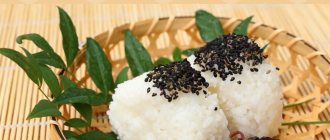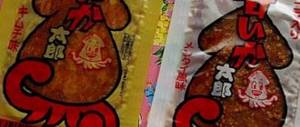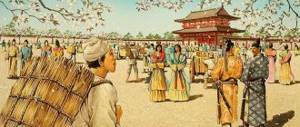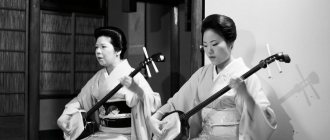Japanese cuisine is not limited to sushi and battered shrimp. The country boasts a variety of unique dishes. Did you know that the Japanese do not use forks and table knives, like to combine salty with sweet, and do not use shelf-stable foods? Read our article for everything you wanted to know about the national cuisine of the Land of the Rising Sun and even more.
Features of Japanese cooking
This national cuisine is undoubtedly one of the most exotic. It is radically different from the European one - in etiquette, serving, and products used.
The main features of Japanese cuisine are:
- eating seasonal food;
- unique table etiquette;
- the use of umami, the taste of protein products, as a base when preparing dishes;
- widespread use of seafood, and a wide variety of them;
- specific serving with an emphasis on the aesthetic appearance of food and the table as a whole;
- small portions. There is a preference for more dishes rather than a single serving size;
- the Japanese do not consume canned or shelf-stable foods, with the exception of rice and various sauces;
- the predominant use of fresh products, during the preparation of which the Japanese try to preserve their original appearance;
- unique cutlery – chopsticks. Some dishes are eaten with hands; spoons are very rarely used. That is why dishes are served in small slices to make it easier to grab with chopsticks;
- lack of forks and knives in serving.
Heian era (710–1185): birth of ritual
The beginning of the so-called aristocratic era in Japanese history dates back to 710, when the first permanent capital was founded in Nara. Imperial banquets of the early Heian period were not particularly luxurious: they consisted of pyramids of multi-colored rice, decorated with millet, and a few rather simple dishes. However, it was at this time that the foundations of Japanese aesthetics were laid, which will remain almost unchanged to this day.
The courtiers and aristocrats of that time - no more than 20 thousand people throughout the country - learn to appreciate not pomp and abundance (which the then imperial court simply could not boast of), but simplicity, elegance, sophistication and understatement. The influence of newly emerging Buddhism also plays a significant role in this. The bureaucrat, prince and warrior must appreciate wordplay, be able to compose short tanka poems and decipher allusions to poetic and literary subjects in bouquets of flowers, fabric patterns, and the combination of fruits on a tray. The hero's inability to recognize the flower encrypted in the poem can lead to suicide. The banal choice of clothing turns out to be an extremely difficult matter: a late 17th-century text describes the fate of an unlucky daimyo, who lost first his possessions and then his life because he was wearing the wrong trousers.
All this greatly influenced the principles of Japanese food and especially serving. Everything that lies on the plate has its own symbolism, and before you eat it, you need to solve the puzzle. Some components of the dish can be added only for their symbolic meaning or to emphasize the desired color scheme and be completely inedible (red maple leaf).
Appearance and symbolism come before taste. The Japanese learn early to appreciate short seasons, of which there are twenty-four in the Heian tradition: it is believed that hatsumono, the first foods to appear in the season, are the most valuable; eating the first seasonal herb or fruit means adding 75 days to your life.
The color of a dish is determined at least by the season, and therefore winter dishes should contain white, autumn dishes yellow and orange, spring dishes pink and green, summer dishes red and green or purple. Associated circumstances also play a role: the combination of red and gold is suitable for important events such as weddings, silver and black for mourning events (in other cases they should be avoided). Texture is valued just as much as color: in Japanese there are more than twenty words describing just different gradations of crispiness; Some foods are valued for their texture rather than their taste, which is either weakly expressed (tofu) or absent at all (konnyaku).
Food is laid out on a plate with painful pedantry: one of the general rules is that the eater should not see one of the components of the dish, no matter from which point he looks (Japanese rock gardens are built on the same principle). They are most often grouped according to the scheme “1 + 3 + 5”, avoiding the unlucky number 4.
It is not difficult to imagine what a complex play the ceremonial banquets of Imperial Japan were transformed into with this approach. Honzen, an established codified type of aristocratic cuisine, was a celebration of fine motor skills, mental arithmetic, and secret meaning. There was no common table at these banquets: each eater was served three, five or seven trays with bowls (five to seven on each), and tradition prescribed a certain type of dish for each corner of each tray, as well as a strict order of dishes and their rules compatibility - depending on the season, locality, occasion, etc. And each of the dishes communicated something to the eater - this property has been preserved by Japanese food to this day.
“At its best, Japanese cuisine is inextricably linked to the aesthetics, religion, traditions and history of the country. They bring back memories of the change of seasons, someone's childhood, a storm at sea. A piece of minced fish in the shape of a maple leaf, subtly colored in scarlet and orange - to celebrate the arrival of autumn. A small house made of planed ice, with a small fish inside made from crushed chestnut and a chestnut made from minced fish. And all this just to remind the distinguished guest that he was born on a distant northern island...”
From the preface to Tsuji Shizuo’s work “Japanese Cuisine” (1978)
Sushi. Print by Ryurukyo Shinsai. XIX century. © Metropolitan Museum of Art
Rice dishes
Rice in Japan is one of the pillars on which the national cuisine is based. Mostly cereals are used, which are highly sticky. This is necessary so that the rice, after heat treatment, forms small lumps that are convenient to pick up with chopsticks.
Rice is prepared as an independent dish and also serves as the basis for various recipes. This cereal goes well with seafood, vegetables, and herbs.
Onigiri
These are rice balls served with various sauces. The name of the dish comes from the word “nigiru”, which means “to compress” in Japanese, which clearly indicates the process of preparing the dish.
Warm, boiled unleavened rice is carefully shaped into plump triangles, often wrapped in dried seaweed nori. There are onigiri with filling, as well as spherical shapes.
Sushi
The dish became widespread in other countries in the 1980s. According to Japanese transcription, it is correct to say "sushi", but throughout the world the pronunciation as "sushi" has taken root. For the dish I use:
- special small-grain Japanese sumeshi rice, also called “vinegar rice”;
- dried seaweed leaves or nori;
- fish, only ocean varieties, because they are less likely to contain parasites. Salmon and tuna fillets can only be used after deep freezing;
- pickled vegetables (most often daikon, ginger);
- wasabi (a special type of horseradish);
- soy sauce;
- rice vinegar.
Sushi can be of various shapes - thin, large, twisted, pressed, etc.
Food culture
In Japan there are rituals and rules for everything. Of course, this also applies to food. For those who are accustomed to using European appliances, it will be useful to become familiar with them before starting a Japanese meal.
Many traditions and rules are associated with chopsticks, which are called “hashi”. There is a special stand for them; it can be ceramic or made of cork, and they should be served in a bright paper case.
There is a rule: if you take food from a common dish, you need to do it with the back of the chopsticks. True, now it is adhered to only in high society. You also can’t wave them around or point at something, it’s impolite. You should not stick them vertically into the rice and pass pieces of food from sticks to sticks; this is done only at funerals.
Sushi is eaten with chopsticks, dipping the edge in soy sauce and biting with ginger. One piece is eaten at a time, but if you still have to bite off half, the rest is not put on the plate, but kept hanging. In a friendly environment, sushi can be eaten with your hands.
The cuisine of the Land of the Rising Sun is rich and varied. I want to introduce you to its main dishes.
Seafood
The peculiarity of Japanese national cuisine is that seafood is subject to minimal heat treatment. Shrimp, fish, and shellfish are steamed or lightly fried, and according to some recipes, seafood is used raw.
Sashimi
The dish is prepared from fish or seafood fillets. The most commonly used are salmon, tuna, shrimp, whale meat, octopus, squid, etc. The products are used raw.
The fillet is cut into small pieces and served with wasabi, soy sauce, shiso leaves and slices of daikon (a spicy rhizome).
Kamakura era (1185–1333): tradition of edible inedible
There is a well-known story of a cook named Kawabata Doki, who at the beginning of the 16th century began every morning to bring home-made oasamono (“morning things”) to the Japanese emperor for breakfast - six baseball-sized rice balls with salted azuki bean paste. Japan was rocked by the battles of samurai clans, the emperor’s life was not very simple (one of the engravings depicting Kawabata Doki at the emperor’s court clearly shows a hole in the roof of the palace), and he was grateful to the cook for these not very tasty, but satisfying koloboks. Soon the emperor could afford to eat something tastier for breakfast, but the tradition had already formed, and Kawabata Doki, and then his descendants, brought oasamono to the emperor, which he did not eat, every day for over three centuries, until 1868.
The story of Kawabata Doki used to be known to every Japanese schoolchild, since until the end of World War II it was taught in schools as an example of devotion to the emperor, but for us it is more interesting as the intersection of two most important trends for Japanese gastronomy that appeared in the Early Middle Ages - devotion to ritual and little-studied tradition inedible food. Although medieval imperial banquets and dinners at the courts of wealthy shoguns are described as extremely elegant, they were primarily oriented towards contemplation.
Many of the dishes served were quite fancy (“snow crab in the shape of a boat”), but were not intended to be eaten: eating them would violate the unwritten rules of the banquet - and could be served for several days in a row, while only simple cold soups, rice and other. It was generally not quite proper for shoguns and emperors to eat at banquets, and medieval texts describe the proper way to bang chopsticks on a tray so that the emperor would appear to his subjects to be enjoying his meal. The same texts remind you that at banquets you will be served a tray of takeaway food before you leave, point out that food should be enjoyed (not eaten), and describe sensitive and appropriate ways to take food away to eat in peace at home: it is best to place it nearby take it with you to the tatami, wrapped in a paper handkerchief, and discreetly grab it before leaving. Wide kimono sleeves are very convenient for this.
The symbolic meaning of sakana, a ritual set of snacks for a set of sake glasses - shikisankona, which precede a classic samurai banquet, is indicative. Trays of sake are passed around the samurai three times, each time accompanied by an established set of snacks that has not changed for centuries: strips of dried konbu seaweed, dried chestnuts and slices of dried abalone (abalone). They were united by the fact that it was impossible to snack on them, or even just bite them in dried form: this is not an appetizer, but a rebus. It read like this: konbu (often pronounced kobu) is consonant with the word “happiness, celebration” (yerokobu). The word for dried abalone, nosi-awabi or simply nosi, also means “victory”; In addition, one of the varieties of dried abalone, which is beaten before drying, is called uti-awabi, which is similar to the warlike verb utte (to crush, to strike). The word for dried chestnuts, katiguri, is also a homonym for “victory.” All together it read as “we will crush the enemy and happily celebrate victory.”
Bamboo shoots and fish. Print by Kawanabe Kyosai. © Artelino
Another example of extremely ritualized culinary skill was shikibocho - the art of cutting food, or more precisely, creating conditionally edible sculptures from fish and game. It was classical art for art's sake, as popular and important as Noh theater and kabuki, the art of ikebana and the tea ceremony. Shikibocho has in common with ikebana an attitude of contemplation, and with noh theater and martial arts - the theatricality of action, divided into a sequence of kata, formalized movements.
Food sculptures that decorated banquets were also popular in Europe: the works of the great French chef Marie Antoine Carême (1784–1833) described how to create massive carved figures from sugar and marzipan - but it was understood that guests could eat them if they wished. Dishes, the symbolic meaning of which outweighs the gastronomic value, are found in different cultures: in the Russian tradition one can recall Easter eggs, funeral kutya or ladders that are baked on the feast of St. John the Climacus - but there are not many examples of dishes that were not originally intended for consumption: for example , sugar figurines of newlyweds from wedding cakes, which are usually kept, or ritual offerings to the deceased, which no one would think of snacking on.
The meaning of shikibocho was the ceremonial transformation of the carcass of a carp or wild bird - preferably a crane, heron or duck - into an exquisite object for admiration. One of the treatises from 1330 mentions a master who was able to cut carp differently every day for a year. The Secret Notes on Culinary Carving from the mid-17th century describes 47 ways to cut carp: “Snowy morning carp”, “Carp watching the moon”, “Carp going to battle”, “Long-living carp”, “Carp admiring a flower”, “Carp choosing a bride”, etc. The shikibocho master usually performed at the beginning or end of the ceremonial banquet; It was forbidden to touch the object with bare hands - he could only use a knife and iron sticks. The master of shikibocho was a hoshonin, literally “master of the cutting knife.” These are the first professional chefs in Japan, who served the shoguns and daimyos, and the authors of the first culinary treatises.
Here are the instructions from the 1898 Encyclopedia of Japanese Cuisine that describe part of such a performance:
“With the knife in your right hand, raise it high above your head. Move the knife to the right, lift your right knee, straighten up. At the same time, raise the chopsticks in your left hand and move your hand to the left until the chopsticks are level with the top of your head. Bring the knife and chopsticks together so that they make a sound. Turn the knife blade to the right to show the surface of the knife. Straighten your arms and stand up. Run your chopsticks along the back of the knife, stopping where the handle meets the blade. Intercept the chopsticks with the thumb of your right hand so that the knife and chopsticks form a cross; raise it in front of you just above your face.”
The rules for choosing fish or game for shikibocho were also formalized:
“The best food is that which is caught in the sea; it is followed by the one caught in the river, while the gifts of the mountains come in last place. This is a general rule, but pheasant is an exception. River fish is valued less than sea fish, but carp is better than any sea fish. According to tradition, game caught in the mountains is least valued. However, game caught in falconry deserves special admiration.”
Shijo school text on cooking (1489)
After cutting, the resulting “long-lived carp” was taken away; his further fate was of no more interest to the hoshonin and his spectators than the fate of the wilted flowers used for ikebana.
As befits a ritual ceremony, every detail had its own symbolic meaning. Thus, the 36 notches on the ceremonial metal sticks used for shikibocho symbolize the 8 volumes and 28 paragraphs of the Lotus Sutra, their length is 1 shaku 8 bu, 108 mental defilements that prevent humanity from achieving enlightenment, and so on. Buddhist traditions directly prohibit killing living beings, and the ethics of Shintoism are built around the concept of defilement, associated, in particular, with death and shedding blood, so the master of shikibocho did everything to, with the help of magical rituals, protect himself and the audience from bad karma associated with murder; The manuscripts convince knife practitioners that, by observing all the formal rules and regulations, they, on the contrary, help the soul of the animal to free itself. Many ancient peoples have this logic (the Yakuts, killing a deer, asked him for forgiveness); Samurai, the main spectators and connoisseurs of shikibocho, used similar logic and magical rituals to justify and justify the need to kill the enemy during battle.
By the end of the 19th century, the tradition of shikibocho was in decline, and by the 20th century it was almost completely forgotten: the art of ritual butchering of a crane could not find followers in the modernist world. However, the cult of kitchen knives and ideal cutting of food, including sashimi, which still exists in Japan today, recipes for which first appear in the Hoshonin treatises, dates back precisely to the medieval craftsmanship of shikibocho.
Cooking. Print by Kitagawa Utamaro. Around 1798–1799. © Art Institute of Chicago
Noodles
Noodle dishes are widespread in Japanese national cuisine. It is used as a side dish, as an ingredient in soups or salads. Most popular dishes:
- ramen - meat or vegetable broth with noodles, cooked in wheat flour, mineral water, with the addition of eggs);
- Soba – noodles made from buckwheat and wheat flour. It is served both cold and hot, boiled or fried, with vegetables or only in broth;
- Udon is a noodle that does not use eggs.
Meat dishes
The Japanese began to use beef and pork in cooking quite late. These ingredients were borrowed from Chinese and European cuisines. Most often, cooked meat is served in thin slices - no more than one mm wide.
Niku-zaga
This is a kind of stew - meat stewed with potatoes, vegetables and spices. The Japanese are more familiar with seafood dishes, so this borrowed dish is not particularly popular in the country.
Soybeans
This type of legume is a product brought from China. But despite this, soy has taken root well in Japanese national cuisine. A wide variety of dishes, sauces and cheeses are prepared from it, for example:
- soy milk - this can be a puree from soaked beans or a decoction of previously fried soybeans;
- Natto is fermented soybeans that have a stickiness and a specific odor. A very popular breakfast option in Japan;
- tofu is a cheese made from soy milk. The product is known for its nutritional value and high protein content;
- edamame - boiled young beans with pods;
- Yuba – foam when soy milk boils while preparing tofu;
- soy sauce - brine obtained by fermenting beans;
- miso - soybean paste. Used as a base ingredient for soups and sauces. The product is a sediment from soy brine.
Influence of China and Europe
Their Chinese neighbors had a significant influence on the formation of the taste preferences of the Japanese. Soybeans and green tea were imported from there.
The barbarian Europeans introduced the inhabitants of the islands to meat. Although, at first they lost consciousness from the smell of beef, they were so disgusted with destroying a living creature. But this soon passed and meat received the status of a familiar product. Archaeologists have found special three-meter holes in the ground, which the islanders used as a refrigerator, storing meat there. It was smoked and preserved with salt.
Soups
Japanese cuisine has many recipes for first courses. Soups come with various ingredients - seaweed, seafood, noodles, meat, potatoes, etc.
Suimono
To prepare the soup you will need seafood, soy sauce, mushrooms (for example, muer, a black woody mushroom used in Asian cuisine, as well as shiitake mushrooms), vegetables, fish and seaweed.
Nabe
This soup has several cooking options - it is boiled with fish or meat (pork is often used). The basic ingredients are also Chinese cabbage, onions, carrots, garlic, sesame oil, etc.
Japanese cuisine is unique not only for its exotic dishes for Europeans, but also for its special food consumption traditions. For example, men can eat sushi with their hands, but women can only eat sushi with chopsticks.
Soups are served in bowls, which are usually raised to chest level. Leaning over soup on the table is not customary in Japan and is considered an undignified act.
Innings
In Japan they are very attentive to detail, this is noticeable when serving food - a young person may be given a larger portion than an older person because they have different metabolisms and need different amounts of food to be full. This also applies to different regions: in the north they eat much more than in the south.
If you come to a Japanese restaurant, the first thing they will do is bring you a towel soaked in hot water to wipe your hands. It's called "oshibori".
Each dish has its own type of cookware. The entire order is brought at once, without dividing into first, second and compote. Only tea is served after everything.
In a traditional Japanese meal, everyone has a separate table and each dish has its own specific place on it. The Japanese prefer dark dishes because white rice looks beautiful on them. When serving, combine round and square shapes in dishes.
In order to heat food, an alcohol lamp or roasting pan is placed on the table.











